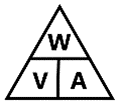Wishlist
0 product in quote list products in quote list 0 products in quote list
No products to quote
In 2022 electricity plays an essential part in our everyday lives. Knowledge of electrical power consumption is extremely useful in work and in your home. The various electrical terms used can be confusing; so here is a simple guide to Volts, Amps and Watts and how to practically apply them.
VOLTS (symbol V)
Volts, named after Italian Physician Alessandro Volta (1745-1827), are a unit of electric potential. This describes the amount of force or pressure a power source will provide. Until a power source, for example a battery cell, is connected to a circuit, the energy can be thought of as only a potential force or pressure. We can compare a battery to a water tower (fig.1) The water is stored high above the ground which creates a great pressure as gravity is acting upon it. The pipe exiting the tank is closed so the water cannot move anywhere, making the water only a potential force.
AMPS (symbol A)
Amperes, commonly known as Amps, are named after French physicist and mathematician, André-Marie Ampere (1775-1836). They represent the flow of electricity past a certain point every second. This is also known as Current (symbol I). It is important as it determines the volume of electrical energy flowing through a wire. Generally, the larger the wire the more electricity will flow. This can be compared to water in a pipe (fig. 2).
WATTS (symbol W)
Watts, named after Scottish inventor James Watt (1736-1819), is the measure of electrical power (symbol P). It describes the amount of energy supplied to or used by a device. Watts are combination of voltage and amps. The volts supply the pressure, the amps supply the volume, and the result, the power, the Watts. Watts can be calculated with this simple equation:
Volts x Amps = Watts
This is also represented by the Watt Triangle: 
Knowing the Watt value for your device and electrical circuit is vitally important. Too little wattage and your device may not work. Too much and your device could be damaged or even catch fire.
Using our water analogy, we can see the Volts represented by the water tower pressure, the Amps by the water flow and the Watts by the power exerted on the water wheel (fig. 3).
If any 2 of the 3 values are known, the 3rd can be calculated. Using the Watt triangle above, if we cover the value required, we’ll find the calculation. For example, to find Amps, cover the A and are left with W over V or Watts divided by Volts.
Cover W and we are left with V by A or Volts x Amps.
